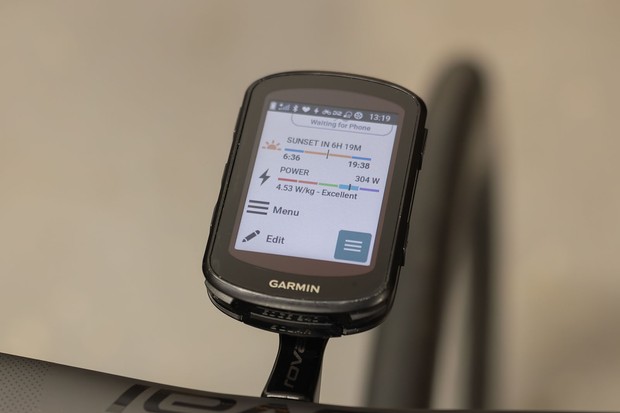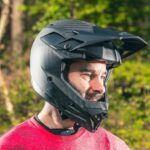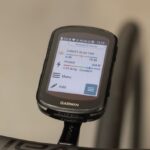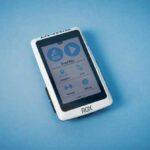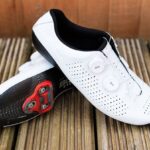The Garmin Edge 840 Solar packs an array of useful features into a compact body. The touchscreen is excellent and the addition of buttons is very welcome when wearing gloves.
Advertisement MPU reviews
It performs the basic functions of a cycling computer very well, connecting to satellites and bike sensors quickly, which enables you to get on with your ride.
The addition of GNSS (Global Navigation Satellite System ) connection has made GPS data almost flawless, while new features such as Climb Pro 2.0, Climb Explore and music controls are all helpful.
The solar functionality, however, doesn’t seem to be worth the additional cost over the standard unit.
It works well and will, on a sunny summer day, add a good amount of battery life over a long ride. But this is location-dependent: the figures on an average UK day simply don’t add enough to justify the cost.
Table des matières
Garmin Edge 840 Solar details and specifications

Scott Windsor / Our Media
The Garmin Edge 840 Solar uses largely the same shape as the outgoing Edge 830.
At 57.8×85.1×19.6mm, it’s slightly longer and thicker than the Edge 830, and 9.8g heavier at 88.9g.
While the Edge 1040 is significantly larger at 59.3×117.6×20.0mm, the Edge 540 Solar uses an identical body.
The Edge 840 Solar’s size offers a nice balance between screen real estate and a compact feel on the bar. This is particularly useful if you mount the unit directly to the stem or bar, but there is an outfront mount included in the box, which provides a less cluttered and tidier solution.
At 88.9g, the Edge 840 Solar is lighter than the larger Edge 1040 Solar at 132g, but heavier than the Wahoo Elemnt Bolt at 68.4g.
The Edge 840 Solar feels solidly built, though with its splashes of chrome around the buttons, the Edge 1040 looks a little more premium than the Edge 840’s black plastic.

Scott Windsor / Our Media
Garmin has moved away from Micro-USB for charging and wired data transfer, now using the USB-C standard.
The Garmin Edge 840 Solar’s screen has large bezels. This means the display size is only 2.6in (6.6cm), despite the overall size of the body.
While this is smaller than some (especially in a world of edge-to-edge screened smartphones), it compares well to the Wahoo Elemnt Bolt at 2.2in (5.6cm).
Simple setup and improved user interface

Scott Windsor / Our Media
Setting up a Garmin device is a very simple process these days. If you are upgrading from an older Garmin Edge device that was connected to the Garmin Connect app, you’ll have the option to import all of your previous data screens and sensors.
Similarly to Wahoo devices, you can now customise your data screens from your phone. This includes changing individual data fields, as well as creating whole new screens.
The functionality is quite basic, but it works well and my unit was soon set up and ready to ride.
With that done, it’s just a case of selecting your ride profile and pressing go. The GPS signal picked up really quickly.
Garmin has also developed a new homescreen. The latest user interface (UI) has been designed primarily for touchscreen units such as this Edge 840 and the Edge 1040.
With more customisation options on offer, it’s easy to have what you want in sight.

Scott Windsor / Our Media
For most of us, this will be our main ride profile, which Garmin displays at the top of the screen. Underneath, the Edge has an adaptable box, which shows your last ride, or uploaded course.
The latter is very helpful when you’ve created a route, transferred it to your phone and you’re just trying to get your ride started.
However, I didn’t find being shown my last ride overly helpful because I (like many people) prefer to analyse my rides on cycling apps such as Strava as I have a well-earned post-ride snack.
The area where this is displayed is also quite large, leaving little room below for any of the glances that Garmin has introduced.
These are small bars that can be expanded when selected to show everything from ride history to an estimate of your current VO2 Max.
You can have as many or as few as you want and how useful they are to you will depend on your needs. On the whole, though, I like the new UI.
Mapping and navigation

Scott Windsor / Our Media
Mapping is still one of the best features about Garmin’s Edge computers. Even in my local area, I tend to create routes using Garmin Connect, both on- and off-road, and I’ve found the navigation on the Edge 840 Solar to be accurate throughout testing.
One handy feature Garmin has added to the Edge 840 and 1040 (but not the 540) is the address search function. This works really well, especially if you’ve got an unfamiliar meetup point.
I must note, however, that the always-on nature of the Climb Pro 2.0 function has massively increased the file sizes.
With its 32GB storage space, that isn’t much of an issue for the Edge 840. However, users also considering the Edge 540 (16GB) will be limited to the map package for one region to free up space.
Solar functionality

Scott Windsor / Our Media
Around the main part of the screen, there’s a red area. That’s the main solar charging panel.
My riding is split between hour-long commutes and longer rides at the weekend. During the former, I struggled to gain more than a minute or two of charge.
On weekend rides, when I tended to leave at around 11am, I seemed to get the most out of the solar technology. On a three-hour ride, I gained an extra 30 minutes of ride time, broadly speaking.
If you ride for longer and on days when the sun is blazing from start to finish, you’ll likely get more.
You can also gain charge with the device in standby mode. As the unit is going to sleep, the display will show the current solar intensity level. Doing this results in only a minor gain in battery charge, but it might get you out of a pinch one day.
While the technology works, I question how much value it’s adding to my experience, and whether it’ll make a huge difference to bikepackers and other all-day riders.
Yes, I’ll have to recharge a little less frequently, but at a €70 premium over the standard Edge 840, I’m not sure it makes enough of a difference to justify the cost.
Instead, I would have preferred Garmin had used this space to increase the size of the screen for a more contemporary look and user experience (at least on the standard Edge 840).
Garmin Edge 840 Solar performance

Scott Windsor / Our Media
While the bells and whistles are clever, the majority of riders simply get on their bike, turn their computer on and press the start button. If I’m not testing a particular feature, it’s what I do too.
The unit is fast to load up, it finds a GPS connection quickly (even when I’m hidden away down by the bike store outside my flat) and a simple press of the start button gets you underway with your preferred ride profile.
Once moving, I found the screen very easy to read. My eyesight is good, so I had no issue bumping the screen brightness down to around 20 per cent for most of my rides.
When the sun was really bright, I sometimes increased this to around 50 per cent because the glossy screen can cause reflections, making data a little tricky to read. However, for the most part, things were perfectly clear.
Climb Pro 2.0
The second generation of Climb Pro results in a climb profile appearing on your screen even when you’re not following a route.
This mimics the latest-generation computers from Wahoo and Hammerhead.
Here, Garmin uses its routing popularity data to make educated guesses about which climb you’re about to tackle. It also uses this data to ascertain where the start and finish of a climb is.
It all works really well for the majority of the time, with only a few instances of the climb segment ending before the summit.
The data is useful on unknown climbs. The colour-coded climb profile that pops up is easy to glance at and understand.
You get average gradient, distance to go and vertical metres left to climb. The small visible section of map is helpful when you come to a junction.
Garmin also enables you to set one or two data fields down at the bottom of the screen.
If you don’t want to see them, they can be turned off, or you can create a ride profile with the feature disabled, as I have done for commuting.
Climb Explore
Swipe down from the top of any screen and you’ll reveal swipeable pages, one of which is a list of climbs in the local area.
Information on the proximity of the climb to you, its gradient and length are displayed. Clicking on one brings up a map of the climb, along with a gradient profile and a ride button.
Clicking this will quickly give you a route to the start of the climb. It’s a very handy feature if you’re on a ride and you fancy exploring a new area.
Music controls
Another of the swipeable pages is a basic music control screen. If you have your phone connected and are playing some bopping tunes through headphones as you ride along, you can now play, pause, skip and rewind tracks from the Garmin.
For a basic function, I found it to be quite buggy. Sometimes, the screen would have to be closed and reopened for the function to work, though I often ended up leaving the music controls open as I cycled to work listening to a Spotify playlist.
Garmin recommends the music controls should only be used when cycling on an indoor trainer (whether you choose to is up to you), but I found this function easier and safer than pulling out my phone to change tracks.
GPS Accuracy
In the past, GPS accuracy had been, for the most part, absolutely fine. But tall buildings and heavily forested areas often led to GPS drift as the signal weakened.
There’s none of that here with the multi-band GNSS. I headed along tree-lined cycle paths and navigated through the most built-up parts of Bristol without a hiccup.
The inclusion of GNSS doesn’t seem to have a negative impact on battery life either.
Garmin Edge 840 Solar bottom line

Scott Windsor / Our Media
Overall, the Garmin Edge 840 Solar is one of the best bike computers you can buy. You’re effectively getting the Edge 1040 in a smaller package.
However, I would save €70 and opt for the non-solar Edge 840. The solar function didn’t add enough to my day-to-day user experience to make it a worthwhile expense, and it’s unlikely to transform the experience of others who need such functionality.
That said, it’s a shame Garmin hasn’t introduced an edge-to-edge display, and features such as the music controls shouldn’t be as buggy as they are.
Advertisement MPU reviews
These gripes aside, I’ve been impressed by the Garmin Edge 840 Solar. There’s no getting away from the fact it’s a very good unit that packs the good stuff from the Edge 1040 into a smaller body.

